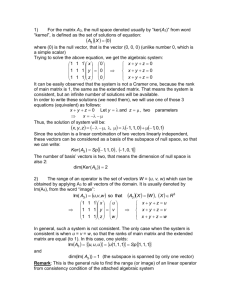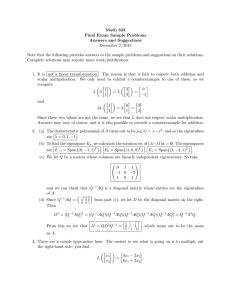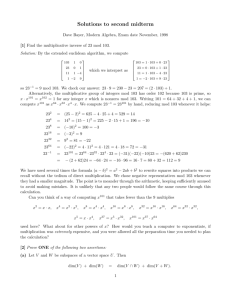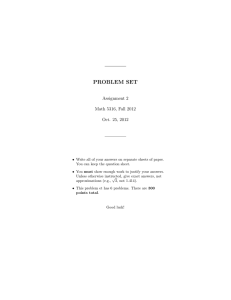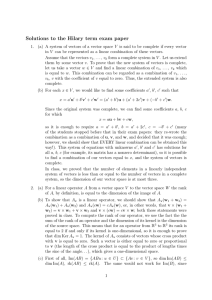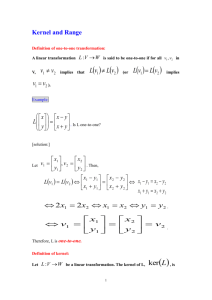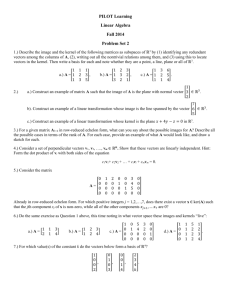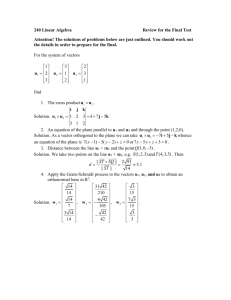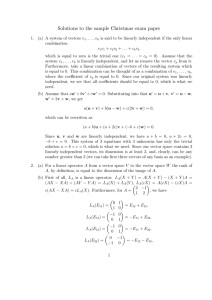Jordan normal form for nilpotent operators: some examples
advertisement
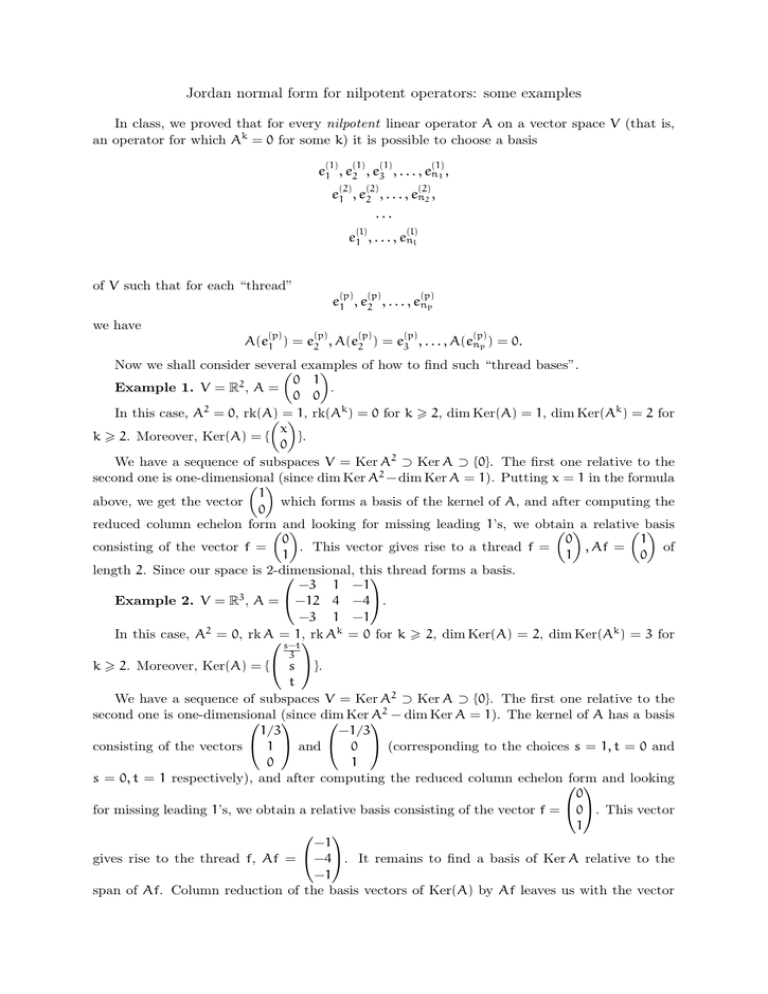
Jordan normal form for nilpotent operators: some examples
In class, we proved that for every nilpotent linear operator A on a vector space V (that is,
an operator for which Ak = 0 for some k) it is possible to choose a basis
(1)
(1)
(1)
(1)
e1 , e2 , e3 , . . . , en1 ,
(2)
(2)
(2)
e1 , e2 , . . . , en2 ,
...
(l)
(l)
e1 , . . . , enl
of V such that for each “thread”
(p)
(p)
(p)
e1 , e2 , . . . , enp
we have
(p)
(p)
(p)
(p)
(p)
A(e1 ) = e2 , A(e2 ) = e3 , . . . , A(enp ) = 0.
Now we shall consider several
of how to find such “thread bases”.
examples
0
1
Example 1. V = R2 , A =
.
0 0
k
k
In this case, A2 = 0, rk(A)
=1, rk(A ) = 0 for k > 2, dim Ker(A) = 1, dim Ker(A ) = 2 for
x
}.
k > 2. Moreover, Ker(A) = {
0
We have a sequence of subspaces V = Ker A2 ⊃ Ker A ⊃ {0}. The first one relative to the
2
second one is one-dimensional
(since dim Ker A − dim Ker A = 1). Putting x = 1 in the formula
1
which forms a basis of the kernel of A, and after computing the
above, we get the vector
0
reduced column echelon form and
basis
looking for missing leading 1’s, we obtain
a relative
1
0
0
of
, Af =
. This vector gives rise to a thread f =
consisting of the vector f =
0
1
1
length 2. Since our space is 2-dimensional,
this
thread forms a basis.
−3 1 −1
Example 2. V = R3 , A = −12 4 −4.
−3 1 −1
2
In this case, A = 0, rk A= 1,rk Ak = 0 for k > 2, dim Ker(A) = 2, dim Ker(Ak ) = 3 for
s−t
3
k > 2. Moreover, Ker(A) = { s }.
t
We have a sequence of subspaces V = Ker A2 ⊃ Ker A ⊃ {0}. The first one relative to the
second one is one-dimensional
dim
A2 − dim Ker A = 1). The kernel of A has a basis
(since
Ker
1/3
−1/3
consisting of the vectors 1 and 0 (corresponding to the choices s = 1, t = 0 and
0
1
s = 0, t = 1 respectively), and after computing the reduced column echelon
form
and looking
0
for missing leading 1’s, we obtain a relative basis consisting of the vector f = 0. This vector
1
−1
gives rise to the thread f, Af = −4. It remains to find a basis of Ker A relative to the
−1
span of Af. Column reduction of the basis vectors of Ker(A) by Af leaves us with the vector
0
g = 1. Overall, f, Af, g form a basis of V. It consists of two threads, one of length 2 (f, Af)
1
and the other one of length 1 (g).
21 −7
8
Example 3. V = R3 , A = 60 −20 23 .
−3
1
−1
−3 1 −1
In this case, A2 = −9 3 −3, A3 = 0, rk A = 2, rk A2 = 1, rk Ak = 0 for k > 3,
0 0 0
dim Ker(A) = 1, dim Ker(A2 ) = 2, dim Ker(Ak ) = 3 for k > 3.
We have a sequence of subspaces V = Ker A3 ⊃ Ker A2 ⊃ Ker A ⊃ {0}. The first one
2
relative to the
one is one-dimensional (dim
Ker A3 − dim
s−tsecond
Ker A = 1). We have
1/3
−1/3
3
2
1
0 (corresponding to
Ker(A ) = { s , so it has a basis of the vectors
and
t
0
1
the choices s = 1, t = 0 and s = 0, t = 1 respectively), and after computing the reduced column
echelon form
basisconsisting
of the
and
looking for missing leading 1’s, we obtain arelative
0
8
−1
vector f = 0. This vector gives rise to the thread f, Af = 23 , A2 f = −3. Since our
1
−1
0
space is 3-dimensional, this thread
forms
a
basis.
1
0 0 1
0 −1 1 0
Example 4. V = R4 , A =
0 −1 1 0 .
−1 0 0 −1
2
k
k
In this case, A = 0, rk(A)
rk(A ) = 0 for k > 2, dim Ker(A) = 2, dim Ker(A ) = 4 for
= 2,
−s
t
k > 2. Moreover, Ker(A) = {
t }.
s
We have a sequence of subspaces V = Ker(A2 ) ⊃ Ker(A) ⊃ {0}. The first one relative
to the
−1
0
second one is two-dimensional (dim Ker(A2 )−dim Ker(A) = 2). Clearly, the vectors
0 and
1
0
1
(corresponding to s = 1, t = 0 and s = 0, t = 1 respectively) form a basis of the kernel of
1
0
A, and after computing the reduced column echelon formand
leading 1’s,
looking formissing
0
0
0
0
we obtain a relative basis consisting of the vectors f1 =
1 and f2 = 0. These vectors
1
0
0
1
1
0
give rise to threads f1 , Af1 =
1 and f2 , Af2 = 0 . These two threads together contain
0
−1
four vectors, and we have a basis.
